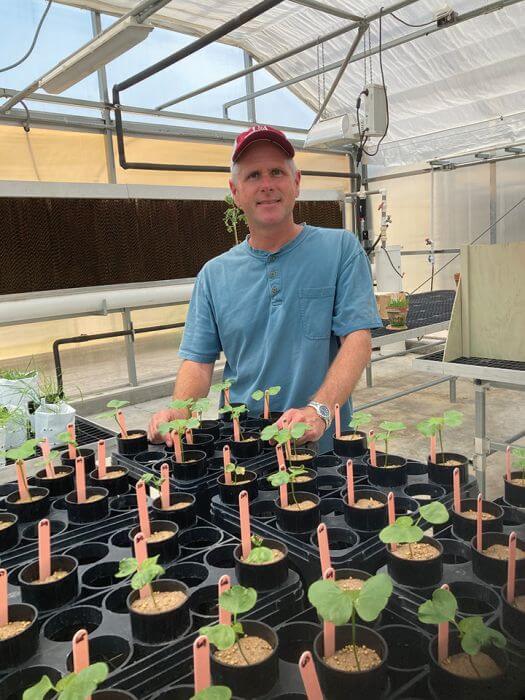
Greenhouse research is an important component of the overall nematicide research conducted by Dr. Travis Faske, professor and Extension plant pathologist, University of Arkansas Lonoke Extension Center — photo by Brenda Carol
Sample In The Fall For Yield-Robbing Nematodes
It’s not a particularly new story. Almost any farmer will tell you what you already know: Nematodes are yield robbers.
It’s been researched, extensively documented and replicated in experimental trials for decades. It’s been broadcast through the Extension service, the ag media and grower meetings.
Why it’s still taking a toll on modern agriculture is somewhat confounding.
“Sometimes I think it’s mostly a matter of ‘what I don’t see isn’t hurting me,’” says Dr. Travis Faske, professor and Extension plant pathologist with the University of Arkansas Lonoke Extension Center. “When it comes to insects, even though they’re tiny, you can see thrips and definitely see the damage on the leaves. Root pests tend to be a different matter.”
Even if a farmer digs up roots to examine what’s going on, it still might not be obvious. “I think most growers are well aware at this point that root-knot nematode forms galls on roots, which are easy to visually detect if you’re looking,” he says. “However, you can’t see the infection with reniform nematode and some of the other nematode species.”
Out Of Sight, Out Of Mind
Because reniform nematode is not immediately apparent, the problem can go undetected for years.
“A grower might notice a spot in the field that’s having a problem and write it off to a problem with irrigation, pesticide application or soil type,” Faske says. “Root-knot thrives in sandier soils, even sandier spots in a field. Reniform is a little sneakier. It usually shows up as a gradual overall demise of crop productivity over a number of seasons.”
That’s why soil sampling is a grower’s best diagnostic tool. Soil samples pulled in the fall can help growers plan intelligently for the following spring.
Meticulous Research
“If you don’t know if you have a problem or the extent of the problem, you’re either shooting in the dark at an unknown target, or even worse, not shooting at all,” Faske says. “There are many different options for nematode management on the market, and more are becoming available every year. It could be a soil-applied nematicide, a seed treatment, a tolerant variety, or even a rotational strategy or a combination of one or more options.”
As an Extension plant pathologist, Faske evaluates the efficacy of nematicides, seed treatments and tolerant varieties each season. It’s painstaking, methodical work, but over the years researchers across the Cotton Belt have developed a wealth of information to help growers address one of the most insidious yield robbers a cotton plant encounters.
“We have field trials and greenhouse trials,” Faske says. “In the field, we plant trials in known nematode infested fields and measure the results in a ‘real-world’ environment. In the greenhouse, it’s a lot more controlled, and we know exactly what we are subjecting a cotton seedling to in a small growing space.”
For greenhouse trials, the nematodes are first cultured on tomato. Those nematode isolates are then transferred to individual trays where various varieties of crop seed are planted into the infested soil medium.
Evaluating Efficacy
Every season Faske and his colleagues evaluate numerous nematicides for efficacy. Those options run the gamut from the tried and true to the experimental and everything in-between.
“There are nematicides such as aldicarb, formerly sold under the brand name Temik and now AgLogic, that we include in our field trials every year,” Faske says. “In terms of non-fumigant nematicides, it is the gold standard for nematode control across a wide range of species. After more than 45 years of data, it’s hard to argue with its performance, so it always provides an excellent benchmark.”
As growers eye the 2021 finish line, nematologists, consultants and Extension agents are ringing that all-important reminder bell once again: Sample fields for nematodes and pay attention to the latest research with an eye on the past.
“There’s no point on compromising next year’s yield when it’s relatively easy to evaluate the upcoming risk in 2022 with a soil sample now and progressively formulate a plan,” Faske says.